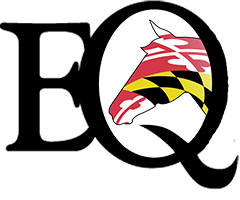by Kimberly K. Egan, MHC President (first published in the July 2023 Equiery)
The Maryland legislature created a new Maryland Thoroughbred Operating Authority in May of 2023. The Authority is separate from the Maryland Racing Commission and its mission is “to maintain the state as a best-in-class Thoroughbred horse racing venue.” One of its itemized powers is to “support and sustain Maryland Thoroughbred racing.” The legislature created the Authority because the Maryland Thoroughbred racing sector is contracting by any relevant measure. The Thoroughbred racing sector is at a crossroads.
The Thoroughbred is the State Horse of Maryland, and Marylanders cherish them as sporting companions far beyond their racing years. Maryland Thoroughbreds are valued by all horse people as lesson horses, competition horses, and friends. Maryland horse people are committed to helping these impressive athletes live their best lives, on and off the track. And we are committed to standing by these horses even as the sector of the industry where they began their careers faces new challenges.
Accordingly, we applaud the General Assembly for creating the new Authority, and we are delighted to have a new partner in government to help us in our own work to support and sustain Maryland Thoroughbreds. The Maryland Horse Council and the Thoroughbred racing sector have been terrific collaborative partners over the years, but there is much work still to be done to bring the many benefits of Maryland’s $2 billion-with-a-b horse industry to bear on the racing sector.
The Thoroughbred Racing Sector: The 1970s and 80s were the Golden Age of Thoroughbred breeding and racing in our state. World famous stallions Native Dancer and Northern Dancer drew global attention to Maryland, and there were three one-mile tracks with signature races. We all agree that era has ended. We are facing the prospect that only one major Thoroughbred track will remain, and many former Thoroughbred farms like Friend’s Choice, Horsepen Hill, Buckingham, Honey Acres, Helmore, and Sycamore Hall now house dressage, lesson, boarding, and carriage driving facilities.
The Thoroughbred racing and breeding sector today is comprised of approximately 4,500 working horses. According to the latest national Jockey Club statistics, there are 26 Thoroughbred stallions standing in Maryland, and there are 780 broodmares. In 2021, there were 618 yearlings and 689 new foals. Laurel Park is home to 1400 horses in training and Pimlico is home to another 200. Eight hundred horses call the Fair Hill Training Center in Cecil County home. According to a 2017 American Horse Council economic impact study, Maryland racing (both Thoroughbred flat racing and Standardbred harness racing) supports 5,214 jobs and has an impact of $572 million, which is about 28% percent of the Maryland horse industry as a whole.
The Larger Maryland Horse Industry: Meanwhile, the over 70% of the horse industry that is not Thoroughbred racing is robust and thriving. In 2023, the Maryland Horse Industry Board (MHIB) licensed a record number of commercial lesson and boarding barns, rescue centers, and trail riding rental operations. In total, 796 operations have been licensed, a nearly 70% increase in licensed stables from just a decade ago. Most of the lesson and boarding barns are full with long waiting lists. These farms alone represent 14,000 horses, and that does not include the thousands of private barns and backyard horse owners across the state.
There are over 97,000 horses in Maryland that are not race horses. We have 10 horses per square mile, the largest concentration of horses in any state in the country. We have over 200 horse organizations in Maryland, and 51.8% of Maryland households contain at least one horse enthusiast. Horse farms comprise 25% of all agricultural land in the state and at least 88,000 of the 705,000 equine acres in Maryland are in permanent agricultural preservation.
We also have a healthy sport horse breeding industry. There are 35 draft horse stallions alone standing in Maryland. There are at least three breeding stations for Hanoverians and several others for other types of European warmbloods. One of the top ten event horse breeders in the world is in Maryland. Maryland-bred Quarter Horses compete all over the country in a variety of western disciplines. Of the 36 breeders who responded to a sport horse survey we conducted earlier this year, 8.3% of them breed Morgans, 8.3% breed Warmbloods, 5.5% breed Irish Sport Horses, 5.5% breed Holsteiners, 5.5% breed Welsh Ponies, and 5.5% breed Highland Ponies. We even have a Lusitano breeder on the Eastern Shore.
2017 data show that the larger horse industry supports over 22,000 jobs and has an annual economic impact in Maryland of at least $1.4 “billion-with-a-b.”
The Competition Sector: Maryland boasts about 30 equestrian disciplines other than racing and, according to our sport horse survey, we are national leaders in several of them.
In 2017, the competition sector supported 3,346 jobs and had a $270 million impact on Maryland’s economy. This sector has grown tremendously since then. Maryland has invested >$20 million in the Fair Hill Special Events Zone, part of a nearly 6,000-acre equestrian destination in Cecil County. The Fair Hill SEZ is home to the new MARS Maryland 5 Star at Fair Hill, one of the most difficult equestrian competitions in the world. Prince George’s County and the Maryland National Capital Park and Planning Commission have invested significantly in the Prince George’s Equestrian Center, which was once the old Marlboro racetrack. In the month of October alone, PGEC attracts over 2,500 horses from around the country to its competitions. The people associated with these competitions book well over 10,000 local hotel rooms each year.
The most popular competition discipline in Maryland is the Olympic discipline of eventing – an equestrian triathlon in which the US dominates. According to our 2023 sport horse survey, approximately 3,000 Maryland horse people participate in eventing. There are more international eventing competitions (19) here in Maryland than anywhere else in North America. The Fair Hill Special Event Zone hosts the MARS Maryland 5 Star, which is 1 of only 7 events of its kind in the world and 1 of only 2 in the United States. MHIB has licensed 50 eventing barns. Each of the 30+ U.S. Pony Clubs in our state has an eventing program.
The Olympic discipline of dressage – a system of training that dates back to Classical Greece and Xenophon’s book The Art of Horsemanship – came in 2nd in our survey. MHIB has licensed about 50 dressage barns. Show jumping – yet another Olympic discipline in which the US dominates – also made a top 5 finish. Every October, Maryland hosts one of the highest rated Show Jumping competitions in the world at the Prince George’s Equestrian Center (PGEC) in Upper Marlboro.
These are just a handful of the over 30 equestrian disciplines in Maryland. Others include 4-H shows, barrel racing, competitive trail riding, cowboy mounted shooting, cutting, draft horse pulling, driving, endurance riding, fox chasing, harness racing, jousting (the State Sport of Maryland), show hunters, mule jumping, polo, polocrosse, ranch riding, reining, rodeo, side saddle, steeplechasing, vaulting, Western dressage, Western equitation, and Working Western, and others. Thoroughbred racing took tenth place in the survey. You can see the results here: https://equiery.com/maryland-horse-sports-survey-results/.
The Equine-Assisted Services (EAS) Sector: Maryland is home to about 40 equine-assisted services centers, many of them located in inner cities and other urban areas. These programs serve diverse and inclusive populations, including veterans (over a dozen programs), first responders, children living with autism, and children and adults living with other health challenges. According to 2017 data, the EAS sector adds about $8.4 million to the state’s economy.
The Recreational Riding Sector: Last but most certainly not least is the recreational riding sector, which represents the largest share of equestrians in the state. According to 2018 data, recreational trail riding and leisure riding support 4,971 jobs and have a total economic impact of $382 million on the Maryland economy. This sector grew substantially during the COVID pandemic as more people turned to outdoor activities and more people took advantage of our state’s extensive system of equestrian trails. The General Assembly has passed several agri-tourism bills in recent sessions which have encouraged the growth of equestrian camping and “glamping.” The Assateague State Park is the biggest tourist attraction in the State, and it is known for the wild Assateague ponies and its excellent equine camping facilities.
* * * * *
What’s all this to do with supporting and sustaining Maryland Thoroughbreds? The racing sector already benefits from the 70% of the Maryland horse industry that is not racing. The larger horse industry sustains Maryland’s hay farmers, equine veterinarians, equine massage therapists, equine chiropractors, equine acupuncturists, farriers, feed companies, horse trailer retailers, tack stores, fence builders, and barn builders. The 70% of the horse industry that is not racing nurtures a child’s early love of horses, teaches the next generation to ride, and introduces Marylanders to the racetrack.
The larger Maryland horse industry also absorbs the Thoroughbred foal crop after their racing careers end. Retired racehorses are sought after by recreational and competition riders for their magnetic personalities, their speed and endurance, and their prodigious work ethic. In 2022 alone, at least 13 Maryland-bred Thoroughbreds competed at the international levels of eventing after their racing careers were over. Sport horse breeders use Maryland-bred Thoroughbred mares in their breeding programs. After racing, Maryland-bred Thoroughbreds teach our newest equestrians how to ride, and provide invaluable services to our therapeutic riding programs for veterans and others.
We hope the new Thoroughbred Racetrack Operating Authority will embrace the role our larger industry plays in supporting and sustaining the Thoroughbred racing sector. We hope the new Authority will help the larger industry continue to help the racing sector, and we hope the new Authority will support the larger industry in our work to help both horses and people.
The larger horse industry puts $1.4 billion into Maryland’s economy each year. It’s time for Maryland to give even a fraction of that money back.












